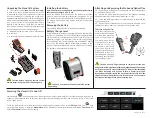
32
It is common for researchers to dark adapt for 24 hours or overnight (Maxwell and Johnson
2000) when making quenching measurements.
It should be noted that NPQ should only be used to compare plants of the same species and
with similar Fv/Fm values (Baker 2008), a (Maxwell and Johnson 2000).
Quenching relaxation measurements are still valuable because there is a significant volume of
literature using puddle model parameters and that literature can be helpful for future research.
One can still delineate state transitions and photoinhibition separately as well. In addition,
with the reconciliation of NPQ to lake model parameters, there is interest in separating state
transitions and photo-inhibition related measurements. There is some overlap between
photoprotective mechanisms and state transitions. Lichtenthaler (1999).
It is valuable to use a PAR Clip and a shroud to measure all quenching parameters. This
ensures that all measurements are made at steady state photosynthesis at a specific light
level
.
The relaxation characteristics of field plants can vary with changing environmental
conditions (Baker 2008).
# 8
After a saturation flash, the tailing off of the signal is the result of NPQ caused by the
saturation flash. According to Rosenqvist and van Kooten (2006) it takes between one and
two minutes for complete dissipation of saturation pulse NPQ. With this in mind, saturation
pulses should be spaced to avoid build up of NPQ. It is also mentioned that photo-damage can
occur to samples when saturation flash intensities are too high and there is no actinic light.
There is evidence that damage does not occur on samples in the light. (Rosenqvist 2006)
Содержание OS1p
Страница 108: ...108 Setting saturation pulse width...
Страница 148: ...148 Microsoft Windows Screen on a PC Microsoft Windows Screen on a PC Select Excel...
Страница 173: ...173 Y II data file format...
Страница 174: ...174 Quenching data file format Hendrickson Klughammer equations...
Страница 175: ...175 RCL Rapid Light Curve data format...
















































